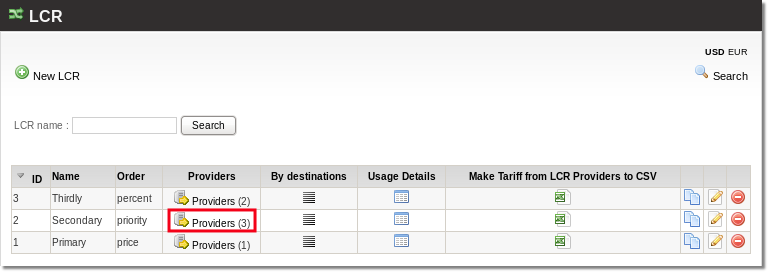Difference between revisions of "How to add Provider to LCR"
| (4 intermediate revisions by 4 users not shown) | |||
| Line 1: | Line 1: | ||
Go to '''SETTINGS –> Billing –> LCR''' | |||
<br><br> | |||
< | [[File:lcr_path.png]] | ||
<br><br> | |||
Press on '''Providers''' which you need, like it is marked in picture below | |||
<br><br> | |||
[[Image:Lcr_by_priority1.png]] | |||
<br><br> | |||
You will reach LCR Providers list | |||
<br><br> | |||
[[File:Lcr_fo_case1.png]] | |||
<br><br> | |||
Here you can [[Image:icon_add.png]]'''Add provider''' which is selected in dropdown by pressing '''Add''' button. | |||
<br><br> | |||
<!---This functionality is available from MOR 12---> | |||
Also you can choose to '''Use only one provider (Turn off failover):''' instead of all Providers in the list. | |||
* When option '''No''' is selected, during the call if it cannot be establish by first provider then system will try with second one, if it cannot be establish by second provider then system will try with third one and so on. | |||
* When option '''Yes''' is selected, during the call will be used just first provider, if call cannot be establish system will not try with any other provider. | |||
<br><br> | <br><br> | ||
=Failover provider= | =Failover provider= | ||
<!---This functionality is available from MOR 12---> | <!---This functionality is available from MOR 12---> | ||
You can also assign a failover provider to a LCR if option ''Use only one provider (Turn off failover):'' is selected ''No''. | You can also assign a failover provider to a LCR if option ''Use only one provider (Turn off failover):'' is selected ''No''. | ||
Failover provider is a provider used only in case of emergency. If all the other providers fail (returns FAILED error code) a failover provider is used. | Failover provider is a provider used only in case of emergency. If all the other providers fail (returns FAILED error code) a failover provider is used. | ||
| Line 16: | Line 29: | ||
'''Warning!''' Failover Provider will be used '''without checking rates.''' You should notice that you can take loss using Failover provider! | '''Warning!''' Failover Provider will be used '''without checking rates.''' You should notice that you can take loss using Failover provider! | ||
It is possible to change User's tariff when the Failover provider is used. By default, the current User's tariff is used. | |||
<br><br> | |||
=See also= | |||
* [[LCR]] | |||
* [[LCR Logic]] | |||
* [[Providers]] | |||
Latest revision as of 15:22, 14 March 2023
Go to SETTINGS –> Billing –> LCR

Press on Providers which you need, like it is marked in picture below

You will reach LCR Providers list

Here you can ![]() Add provider which is selected in dropdown by pressing Add button.
Add provider which is selected in dropdown by pressing Add button.
Also you can choose to Use only one provider (Turn off failover): instead of all Providers in the list.
- When option No is selected, during the call if it cannot be establish by first provider then system will try with second one, if it cannot be establish by second provider then system will try with third one and so on.
- When option Yes is selected, during the call will be used just first provider, if call cannot be establish system will not try with any other provider.
Failover provider
You can also assign a failover provider to a LCR if option Use only one provider (Turn off failover): is selected No.
Failover provider is a provider used only in case of emergency. If all the other providers fail (returns FAILED error code) a failover provider is used.
If Provider returns NO ANSWER or BUSY - it means, that call not FAILED.
If you think that NO ANSWER/BUSY == FAILED, then you can use this setting
Warning! Failover Provider will be used without checking rates. You should notice that you can take loss using Failover provider!
It is possible to change User's tariff when the Failover provider is used. By default, the current User's tariff is used.
